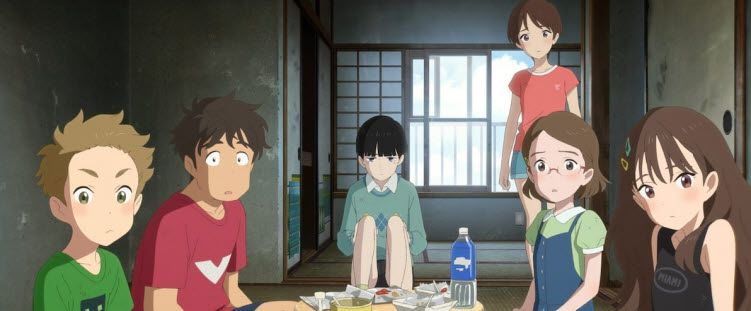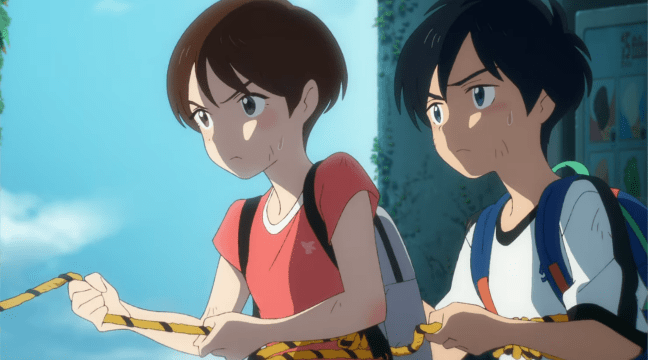Japanese animation feature film “Drifting Home”, which was released on Netflix a few days ago, begins with an intriguing story idea to hold your attention for a while, but it only comes to disappoint us due to several flaws in terms of story and characters. While there are a number of wonderful visual moments to savor, the film is often hampered by rote melodrama and flat characterization, and we simply come to observe its drift from the distance without much care.
At first, the story mainly revolves around the strained relationship between two school kids who were once very close to each other. When her parents had a divorce, Natsume (voiced by Asami Seto) was under the care of a benevolent old neighbor for some time, and she and that neighbor’s grandson Kōsuke (voiced by Mutsumi Tamura) become each other’s best friend as spending a lot of time together, though she was eventually taken back to her divorced mother not long after the death of Kōsuke’s grandfather.
While they are still going to the same school in addition to being the members of its soccer club, Kōsuke has been hesitating to get closer to Natsume again, and Natsume also hesitates a lot due to her own personal reason. Besides, there is a popular girl in their school quite interested in getting some attention from Kōsuke, and her presence certainly makes Natsume and Kōsuke more awkward to each other.
Meanwhile, the summer vacation is soon started, and Kōsuke and his two close friends, Taishi (voiced by Yumiko Kobayashi) and Yuzuru (voiced by Daiki Yamashita) sneak into an old apartment complex which was once their neighborhood but is now waiting for demolition and subsequent redevelopment. There has been a rumor about a ghost living in one of the apartment buildings, and they are eager to confirm whether there is actually a ghost living there.
Incidentally, that apartment building in question is the one where Kōsuke’s grandfather resided, and Kōsuke and his friends soon come across Natsume, who turns out to know something about the apartment building. According to her, there is some boy living in the apartment building, but Kōsuke and his friends do not believe her much, and things become more complicated when popular schoolgirl, Reina (voiced by Inori Minase), and her best friend Juri (voiced by Kana Hanazawa) come after noticing Kōsuke and others on the rooftop of the apartment building.
And then something suddenly happens to their befuddlement. Lots of rain is poured onto them and the apartment building, and, what do you know, Kōsuke and other kids are shocked and surprised to find that the apartment building is now drifting alone in the middle of some vast sea for no apparent reason. Furthermore, it turns out that there is indeed a ghost in the apartment, and the ghost, who appears as an older boy called Noppo (voiced by Ayumu Murase), seems to be connected with this inexplicable circumstance surrounding Kōsuke and other kids.
Once they come to realize that they are stuck in the apartment building with no apparent chance for escape, Kōsuke and other kids try to survive day by day as much as they can, and we accordingly get a montage sequence briefly showing how they stick together during next several days. Fortunately, Natsume stored some food and snack in the apartment just in case, and it also turns out later in the story that there are some good opportunities for Kōsuke and other kids to get some extra food for their survival.
Meanwhile, the story by director Hiroyasu Ishida and his co-writers Hayashi Mori and Minaka Sakamoto attempts to go into more details on what is exactly happening around its young main characters, but what follows next is not particularly interesting on the whole. While it becomes clear to us that our young main characters are stuck in some kind of alternative universe, the film often fails to amaze or enchant us as merely drifting from one point to another, and the sudden inclusion of on substantial supporting character during its last act is rather distracting instead of being surprising or inspiring.
Above all, the main characters of the story are not particularly developed well enough to engage us, and most of them remain to be no more than bland plot elements. While the strained relationship between Kōsuke and Natsume is supposed to be the heart and soul of the story, it is not that interesting enough as often stuck in contrived melodramatic moments, and their relationships with Noppo do not have much gravitas as this ghost character often feels non-existent in its airy passive appearance. As a result, we do not care that much about the melodramatic situation among these three main characters during the last act of the film, and that is the main reason why the finale seriously lacks dramatic impact.
In conclusion, “Drifting Home” is dissatisfying for not generating enough wonder and interest from its story and characters. It is not a total waste of time at least due to its competent cell animation style and some good visual moments including the one involved with some other drifting place, but I also must point out that it is still substandard compared to many better Japanese animation films out there such as those sublime works from Studio Ghibli such as “Ponyo” (2008), which incidentally came to my mind for a good reason when I watched “Drifting Home” yesterday. I will let you decide on whether you will watch “Drifting Home”, but I really think you will have a more entertaining time with “Ponyo”.










